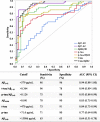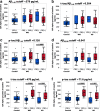The relevance of cerebrospinal fluid α-synuclein levels to sporadic and familial Alzheimer's disease
- PMID: 30477568
- PMCID: PMC6260771
- DOI: 10.1186/s40478-018-0624-z
The relevance of cerebrospinal fluid α-synuclein levels to sporadic and familial Alzheimer's disease
Abstract
Accumulating evidence demonstrating higher cerebrospinal fluid (CSF) α-synuclein (αSyn) levels and αSyn pathology in the brains of Alzheimer's disease (AD) patients suggests that αSyn is involved in the pathophysiology of AD. To investigate whether αSyn could be related to specific aspects of the pathophysiology present in both sporadic and familial disease, we quantified CSF levels of αSyn and assessed links to various disease parameters in a longitudinally followed cohort (n = 136) including patients with sporadic mild cognitive impairment (MCI) and AD, and in a cross-sectional sample from the Dominantly Inherited Alzheimer's Network (n = 142) including participants carrying autosomal dominant AD (ADAD) gene mutations and their non-mutation carrying family members.Our results show that sporadic MCI patients that developed AD over a period of two years exhibited higher baseline αSyn levels (p = 0.03), which inversely correlated to their Mini-Mental State Examination scores, compared to cognitively normal controls (p = 0.02). In the same patients, there was a dose-dependent positive association between CSF αSyn and the APOEε4 allele. Further, CSF αSyn levels were higher in symptomatic ADAD mutation carriers versus non-mutation carriers (p = 0.03), and positively correlated to the estimated years from symptom onset (p = 0.05) across all mutation carriers. In asymptomatic (Clinical Dementia Rating < 0.5) PET amyloid-positive ADAD mutation carriers CSF αSyn was positively correlated to 11C-Pittsburgh Compound-B (PiB) retention in several brain regions including the posterior cingulate, superior temporal and frontal cortical areas. Importantly, APOEε4-positive ADAD mutation carriers exhibited an association between CSF αSyn levels and mean cortical PiB retention (p = 0.032). In both the sporadic AD and ADAD cohorts we found several associations predominantly between CSF levels of αSyn, tau and amyloid-β1-40.Our results suggest that higher CSF αSyn levels are linked to AD pathophysiology at the early stages of disease development and to the onset of cognitive symptoms in both sporadic and autosomal dominant AD. We conclude that APOEε4 may promote the processes driven by αSyn, which in turn may reflect on molecular mechanisms linked to the asymptomatic build-up of amyloid plaque burden in brain regions involved in the early stages of AD development.
Keywords: APOEε4; Alzheimer’s disease; Biomarkers; Mild cognitive impairment; alpha-synuclein.
Conflict of interest statement
Ethics approval and consent to participate
Research aims pursued in the longitudinal cohort were approved by the regional ethics committee in Trondheim, Norway (2010/226) and Stockholm, Sweden (2016/771–31/4). The described studies relating to the DIAN cohort wereapproved by the local ethics committee in Stockholm, Sweden (2016/2114–31/4). The studies of both cohorts were carried out in agreement with the Helsinki Declaration.
Consent for publication
Not applicable.
Competing interests
The authors declare that they have no competing interests.
Publisher’s Note
Springer Nature remains neutral with regard to jurisdictional claims in published maps and institutional affiliations.
Figures










Similar articles
-
Osteopontin: A novel marker of pre-symptomatic sporadic Alzheimer's disease.Alzheimers Dement. 2024 Sep;20(9):6008-6031. doi: 10.1002/alz.14065. Epub 2024 Jul 28. Alzheimers Dement. 2024. PMID: 39072932 Free PMC article.
-
Concordance and Diagnostic Accuracy of [11C]PIB PET and Cerebrospinal Fluid Biomarkers in a Sample of Patients with Mild Cognitive Impairment and Alzheimer's Disease.J Alzheimers Dis. 2015;45(4):1077-88. doi: 10.3233/JAD-142952. J Alzheimers Dis. 2015. PMID: 25649653
-
Habitual exercise levels are associated with cerebral amyloid load in presymptomatic autosomal dominant Alzheimer's disease.Alzheimers Dement. 2017 Nov;13(11):1197-1206. doi: 10.1016/j.jalz.2017.03.008. Epub 2017 May 11. Alzheimers Dement. 2017. PMID: 28501451 Free PMC article.
-
α-synuclein in the pathophysiology of Alzheimer's disease.Mol Neurodegener. 2019 Jun 11;14(1):23. doi: 10.1186/s13024-019-0320-x. Mol Neurodegener. 2019. PMID: 31186026 Free PMC article. Review.
-
Relationships Between Diffusion Tensor Imaging and Cerebrospinal Fluid Metrics in Early Stages of the Alzheimer's Disease Continuum.J Alzheimers Dis. 2019;70(4):965-981. doi: 10.3233/JAD-181210. J Alzheimers Dis. 2019. PMID: 31306117 Free PMC article. Review.
Cited by
-
The probabilistic model of Alzheimer disease: the amyloid hypothesis revised.Nat Rev Neurosci. 2022 Jan;23(1):53-66. doi: 10.1038/s41583-021-00533-w. Epub 2021 Nov 23. Nat Rev Neurosci. 2022. PMID: 34815562 Free PMC article. Review.
-
Plasma apolipoprotein E levels in longitudinally followed patients with mild cognitive impairment and Alzheimer's disease.Alzheimers Res Ther. 2022 Aug 24;14(1):115. doi: 10.1186/s13195-022-01058-9. Alzheimers Res Ther. 2022. PMID: 36002891 Free PMC article.
-
Insulin Resistance Exacerbates Alzheimer Disease via Multiple Mechanisms.Front Neurosci. 2021 Jul 19;15:687157. doi: 10.3389/fnins.2021.687157. eCollection 2021. Front Neurosci. 2021. PMID: 34349617 Free PMC article. Review.
-
Novel blood test for early biomarkers of preeclampsia and Alzheimer's disease.Sci Rep. 2021 Aug 5;11(1):15934. doi: 10.1038/s41598-021-95611-5. Sci Rep. 2021. PMID: 34354200 Free PMC article.
-
Apolipoprotein E4-driven effects on inflammatory and neurotrophic factors in peripheral extracellular vesicles from cognitively impaired, no dementia participants who converted to Alzheimer's disease.Alzheimers Dement (N Y). 2021 Jan 28;7(1):e12124. doi: 10.1002/trc2.12124. eCollection 2021. Alzheimers Dement (N Y). 2021. PMID: 33537405 Free PMC article.
References
-
- Berge G, Lauridsen C, Sando SB, Holder DJ, Møller I, Aasly JO, et al. Effect of Tween-20 on Core biomarkers measured in cerebrospinal fluid from patients with Alzheimer’s disease, mild cognitive impairment, or healthy control individuals. J Alzheimer’s Dis. 2015;49:493–502. doi: 10.3233/JAD-150234. - DOI - PubMed
Publication types
MeSH terms
Substances
Grants and funding
LinkOut - more resources
Full Text Sources
Other Literature Sources
Medical

